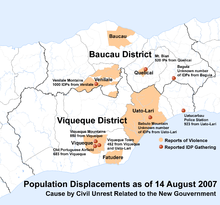Baguia
| Baguia | ||
|---|---|---|
|
|
||
| Coordinates | 8 ° 38 ′ S , 126 ° 40 ′ E | |

|
||
| Basic data | ||
| Country | East Timor | |
| Baucau | ||
| Administrative office | Baguia | |
| ISO 3166-2 | TL-BA | |
| Suco | Alawa Craik and Alawa Leten | |
|
Baguia
|
||
Baguia ( Baquia , Bagia , obsolete: Baaguia ) is an East Timorese town in the municipality of Baucau . Baguia is the capital of the Baguia Administrative Office . The place name derives from the Makasae Language designation ba'a gia from, which means, like (village) in the mountain hollow .
geography
The village is located inland in the southeast of the municipality of Baucau, at an altitude of 294 m above sea level. It consists of the districts Alaua , Maurubi-assa , Ne Olidae and Ua-Sufa , referring to the Sucos Alawa Craik and Alawa Leten distribute.
Infrastructure
The houses are mostly made of bamboo with a thatched roof. Overland roads connect Baguia with the outside world. The municipal capital Baucau can be reached in four hours from Baguia by bus or truck every day. After Baucau it is just under 30 km to the northwest as the crow flies and about 124 km to the west to the state capital Dili , to which a bus runs irregularly from Baguia in seven hours. Telephone and postal services are limited. Baguia is the only place in the administrative office that has electricity from a generator, but it only runs from seven in the evening until midnight.
The place has a primary school, two pre-secondary schools, a community health center, and a helipad. There is a market in Baguia twice a week. The Forte de Baguia, a Portuguese fort from 1912 , still stands in the village . Two kilometers from Baguia are the ruins of the Escola do Reino de Haudere school from the 1930s. After the Second World War it fell apart, so that today only the walls remain.
history
On June 10, 1959, insurgents attacked the Portuguese fort in Baguia during the Viqueque Rebellion . The attack could be repulsed, whereupon the rebels withdrew again to the Uato-Lari / Uatucarbau region .
In 1976, Baguia's mountainous terrain was a retreat for the FALINTIL , who fought against the Indonesian invaders. Here they founded a base de apoio , a resistance base that offered refuge for refugees from Lospalos , Baguia, Iliomar and Uatucarbau. The base was later destroyed by the Indonesians.
After the fall of the Matebian resistance base in late November 1978, thousands of people came to Baguia. They were forbidden to move further from the place and were closely guarded. Cholera , diarrhea and tuberculosis broke out. Of the people who came from Osso Huna alone, 280 people died. Other village communities mourn over 500 deaths.
In Baguia and Ledana (Suco Lavateri) there were Indonesian camps for East Timorese at the end of 1979, who were supposed to be relocated by the occupiers for better control.
On August 10, 2007, during the unrest after the 2007 parliamentary elections, the Convent of the Salesians of Don Bosco and the affiliated orphanage were attacked. Nine girls including an eight-year-old were raped. Before that, the rioters devastated the entire convention. The incident caused quite a stir and is considered to be one of the worst incidents during the riots. The perpetrators are said to be supporters of FRETILIN . The next day, a 16-year-old accused of raping the child was arrested. Several people in Baguia fled their homes due to the unrest.
At 2 a.m. on March 8, 2015, a group attacked the local police station with firearms and homemade explosives. Three police officers who stayed in the building as the bodyguard of President Vicente da Silva Guterres were injured. The President of Parliament was in town for the funeral of a relative and was in a nearby building, but was probably not the target of the attack and was unharmed. In addition to the police station, the local Liurai's house and at least two other houses also burned. Vehicles were also damaged. According to police sources, the attackers are said to belong to the Konseilu Revolusionariu Maupe (KRM, German Revolutionary Council Maupe ) around Mauk Moruk . This denied a participation of the KRM.
Sons and daughters
- Vicente da Silva Guterres (* 1955), politician
- Adaljíza Magno (* 1975), politician
Web links
Individual evidence
- ↑ a b Internal Displacement Monitoring Center ( Memento of the original from September 24, 2011 in the Internet Archive ) Info: The archive link was automatically inserted and not yet checked. Please check the original and archive link according to the instructions and then remove this notice. (PDF; 464 kB)
- ^ Ernest Chamberlain: The 1959 Rebellion in East Timor: Unresolved Tensions and an Unwritten History , accessed September 7, 2013
- ↑ a b c "Chapter 7.3 Forced Displacement and Famine" ( Memento of the original from November 28, 2015 in the Internet Archive ) Info: The archive link was inserted automatically and has not yet been checked. Please check the original and archive link according to the instructions and then remove this notice. (PDF; 1.3 MB) from the "Chega!" Report by CAVR (English)
- ↑ UCAN: August 15, 2007, Convent girls raped, church property destroyed as new PM takes office
- ↑ Reuters, August 13, 2007, Youth arrested over alleged rape at E. Timor convent
- ↑ SAPO Notícias: Governo a tomar medidas para controlar situação em Baguia , March 8, 2015 , accessed on March 8, 2015.
- ↑ SAPO Notícias: Mauk Moruk nega envolvimento no ataque à esquadra da vila timorense de Baguia , March 10, 2015 , accessed on March 11, 2015.








